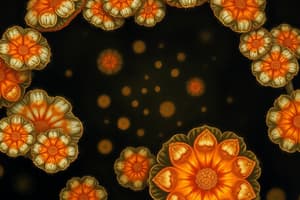Podcast
Questions and Answers
What is the most frequently used entry site for microbes?
What is the most frequently used entry site for microbes?
- Conjunctiva
- Respiratory tract (correct)
- Gastrointestinal tract
- Genitourinary tract
What type of tissue lines the portals of entry discussed in microbial pathogenesis?
What type of tissue lines the portals of entry discussed in microbial pathogenesis?
- Connective tissue
- Muscle tissue
- Epithelial tissue (correct)
- Bone tissue
Which entry site must microbes survive stomach HCl, enzymes, and bile?
Which entry site must microbes survive stomach HCl, enzymes, and bile?
- Genitourinary tract
- Skin
- Gastrointestinal tract (correct)
- Respiratory tract
For which type of entry site do microbes often gain access through hair follicles and sweat glands?
For which type of entry site do microbes often gain access through hair follicles and sweat glands?
Which entry site is commonly associated with sexually transmitted diseases?
Which entry site is commonly associated with sexually transmitted diseases?
Which of the following is the easiest and most frequently used entry site for microbes?
Which of the following is the easiest and most frequently used entry site for microbes?
What must microbes do to cause disease in a host?
What must microbes do to cause disease in a host?
Which portal of entry involves the membrane covering the eyes and eyelids?
Which portal of entry involves the membrane covering the eyes and eyelids?
Which of the following statements is true about the gastrointestinal tract as a portal of entry?
Which of the following statements is true about the gastrointestinal tract as a portal of entry?
Through which structures do some microbes gain access to an otherwise impenetrable skin?
Through which structures do some microbes gain access to an otherwise impenetrable skin?
Flashcards are hidden until you start studying
Study Notes
Microbial Pathogenesis
Entry into the Host
- Microbes must access and adhere to host tissues, penetrate or evade host defenses, and damage tissue to cause disease.
Portals of Entry
- There are three main portals of entry for microbes: mucous membranes, skin, and parenteral.
Mucous Membranes
- Epithelial tissue lining the respiratory tract is the easiest and most frequently used entry site for microbes.
- The gastrointestinal tract is another common entry site, with microbes entering through water, food, contaminated fingers, and fomites.
- Microbes must survive stomach HCl, enzymes, and bile to enter the gastrointestinal tract.
- The genitourinary tract is the entry site for most sexually transmitted diseases.
- The conjunctiva, a membrane covering the eyes and eyelids, is also a portal of entry for microbes.
Skin
- Unbroken skin is impenetrable by most microbes.
- Some microbes can gain access to the host through hair follicles and sweat glands.
Studying That Suits You
Use AI to generate personalized quizzes and flashcards to suit your learning preferences.




